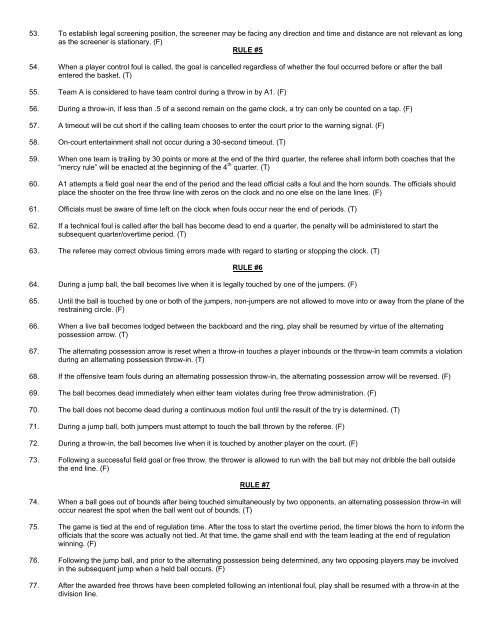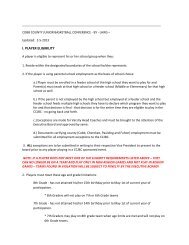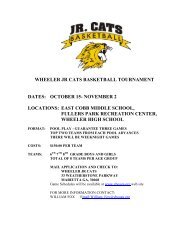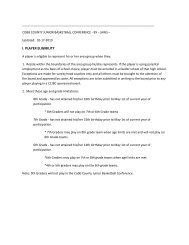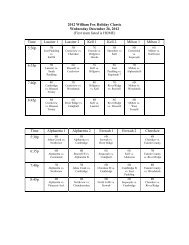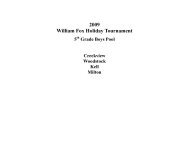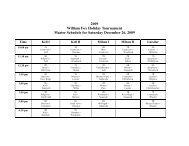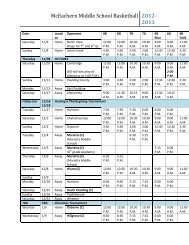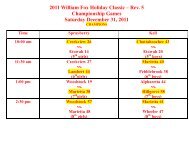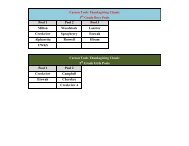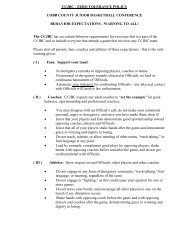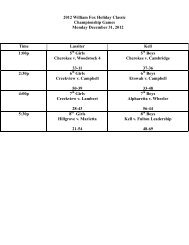2010-11 ghsa basketball rules study guide - ccjbc
2010-11 ghsa basketball rules study guide - ccjbc
2010-11 ghsa basketball rules study guide - ccjbc
- No tags were found...
You also want an ePaper? Increase the reach of your titles
YUMPU automatically turns print PDFs into web optimized ePapers that Google loves.
53. To establish legal screening position, the screener may be facing any direction and time and distance are not relevant as longas the screener is stationary. (F)RULE #554. When a player control foul is called, the goal is cancelled regardless of whether the foul occurred before or after the ballentered the basket. (T)55. Team A is considered to have team control during a throw in by A1. (F)56. During a throw-in, if less than .5 of a second remain on the game clock, a try can only be counted on a tap. (F)57. A timeout will be cut short if the calling team chooses to enter the court prior to the warning signal. (F)58. On-court entertainment shall not occur during a 30-second timeout. (T)59. When one team is trailing by 30 points or more at the end of the third quarter, the referee shall inform both coaches that the“mercy rule” will be enacted at the beginning of the 4 th quarter. (T)60. A1 attempts a field goal near the end of the period and the lead official calls a foul and the horn sounds. The officials shouldplace the shooter on the free throw line with zeros on the clock and no one else on the lane lines. (F)61. Officials must be aware of time left on the clock when fouls occur near the end of periods. (T)62. If a technical foul is called after the ball has become dead to end a quarter, the penalty will be administered to start thesubsequent quarter/overtime period. (T)63. The referee may correct obvious timing errors made with regard to starting or stopping the clock. (T)RULE #664. During a jump ball, the ball becomes live when it is legally touched by one of the jumpers. (F)65. Until the ball is touched by one or both of the jumpers, non-jumpers are not allowed to move into or away from the plane of therestraining circle. (F)66. When a live ball becomes lodged between the backboard and the ring, play shall be resumed by virtue of the alternatingpossession arrow. (T)67. The alternating possession arrow is reset when a throw-in touches a player inbounds or the throw-in team commits a violationduring an alternating possession throw-in. (T)68. If the offensive team fouls during an alternating possession throw-in, the alternating possession arrow will be reversed. (F)69. The ball becomes dead immediately when either team violates during free throw administration. (F)70. The ball does not become dead during a continuous motion foul until the result of the try is determined. (T)71. During a jump ball, both jumpers must attempt to touch the ball thrown by the referee. (F)72. During a throw-in, the ball becomes live when it is touched by another player on the court. (F)73. Following a successful field goal or free throw, the thrower is allowed to run with the ball but may not dribble the ball outsidethe end line. (F)RULE #774. When a ball goes out of bounds after being touched simultaneously by two opponents, an alternating possession throw-in willoccur nearest the spot when the ball went out of bounds. (T)75. The game is tied at the end of regulation time. After the toss to start the overtime period, the timer blows the horn to inform theofficials that the score was actually not tied. At that time, the game shall end with the team leading at the end of regulationwinning. (F)76. Following the jump ball, and prior to the alternating possession being determined, any two opposing players may be involvedin the subsequent jump when a held ball occurs. (F)77. After the awarded free throws have been completed following an intentional foul, play shall be resumed with a throw-in at thedivision line.


